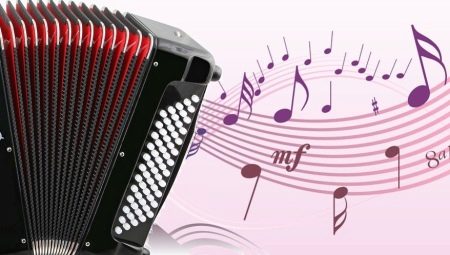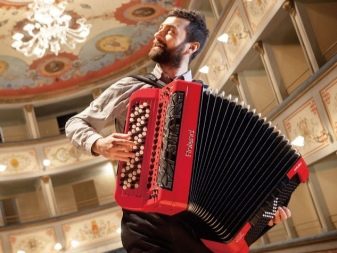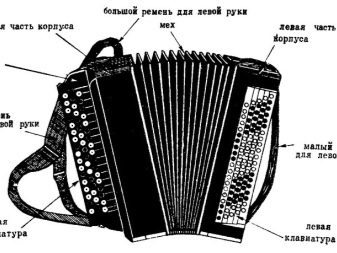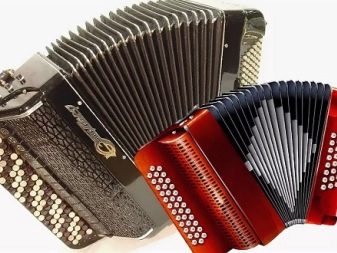What is the difference between accordion and accordion?

The accordion and accordion are obviously relatives, but not everyone knows how close they are, and what fundamental differences they have. There are those who are sure: this accordion is the button accordion, just a more popular name. But this is not the case. First of all, the tools differ structurally. But the fact that the history of their emergence and development is closely intertwined is true.


Comparison of appearance
The accordion is a reed pneumatic keyboard instrument consisting of two keyboards connected by bellows. Due to the blowing of air by the bellows, and the pressing of buttons on the keyboard, the metal plates begin to move. They vibrate under the action of an air stream, and this gives rise to sound. The harmony can have one, two or three button rows on the right and always only one on the left. The right keyboard is the melody, the left is the accompaniment.


The accordion can be considered an improved accordion. This instrument already has a full chromatic scale on the right, and on the left - bass or ready-select (or ready-made chord) accompaniment. Since the instrument is equipped with a keyboard and built-in registers, it can deftly imitate other musical objects used in a symphony orchestra.
Needless to say, if a concert button accordion has a sound range of 5 octaves and 6 semitones. The accordion cannot boast of such wealth.


If you look closely at the keyboard right away, then it is the number of rows on the left that will be the main difference between the tools. In the accordion, this row modestly flaunts without any neighbors, and in the accordion, it is always surrounded by them. In addition, the dimensions are also striking - the accordion will be smaller. Although both instruments are variable in their sizes, there are children's accordions that may be less harmonic.


Assessment of the keyboard of two instruments:
- in the button accordion, white keys are interspersed with black (although there is also a one-color keyboard, but less often), and on black the button accordion player manages to extract semitones that are impossible for accordion;
- on the left keyboard of the button accordion, you can immediately see a huge number of buttons - up to 100 in student instruments and over 100 in professional ones, the accordion does not have such a number.
But the layman rarely at first glance will determine what kind of instrument is in front of him. If you put the button accordion and accordion next to it, he will see the differences, if not, it is not at all necessary. The instruments are related, once the button accordion became a new accordion, its modernized version, hence the confusion. Although the musicians, of course, will immediately tell you where the difference is hidden, and why it is so significant.

What is easier to play on?
After such a description, the answer seems to be obvious - on the accordion. And it would be strange to argue with him. It was the relatively simple device of the instrument that led to the fact that it became absolutely popular. By the way, it is called accordion only in Russia, in other countries the name “harmonica” has taken root. The first attempts to make a Russian harmonica are associated with the gunsmith Timofei Vorontsov, but still Ivan Sizov is considered the true parent of harmony.
Having bought a five-valve accordion at the fair, he took it apart and tried to make his own instrument. And he did, and even brought it to mass production. Tula became the first Russian place where the accordion appeared, then the instrument began to conquer Saratov, Nizhny Novgorod and other cities. The instrument quickly fell in love with people: it sounds both "elegant" and piercing, you can master it by ear, and how good it is for folk festivals and festivities.


Tula (still the same rich in talents Tula) amateur accordionist Beloborodov decides to complicate the construction of the accordion, and together with the master Chulkov in 1871 he makes a two-row instrument. And after another 20 years, a three-row sample already sees the light, but this is the merit of the German master Mirwald. Finally, in 1907, Pyotr Sterligov made a four-row accordion, and he was given the name "button accordion". One tool gave birth to another - and all this thanks to the efforts of folk nuggets, who saw the possibility of perfection and went to it.
The answer to the question of what is easier to play is also in plain sight: since so many people have mastered the accordion, therefore, even without knowing the musical notation, it is not difficult to do it. If you have the ability, it really is not difficult. Although the button accordion is mastered by people who have not studied solfeggio. As for musicians who can play both instruments, they note that there is a huge difference between “learning” and “developing” in playing.
Yes, it will be easier to play the accordion, but if you switch only to the button accordion for a couple of months, it may be difficult to switch back. Fingering (finger placement) changes, and it takes time to adapt to the previous one.

Other differences
The difference concerns mainly the device and capabilities of the fellows. How to distinguish a button accordion from an accordion:
- the musical possibilities of the accordion are much wider than the playing potential of the accordion;
- 5 rows of the keyboard on the right side of the button accordion certainly outperforms 1-3 rows of the accordion;
- the accordion's pitch does not depend on how the bellows move, but in the accordion, the sound and pitch characteristics are set specifically by this parameter;
- the button accordion makes it possible to perform musical works of large forms (for example, to play arias), which the accordion cannot do;
- the main difference is the scale, for the accordion it is chromatic, for the accordion it is diatonic (to put it simply, you can compare the accordion with the piano, and imagine that the piano would be played only with white keys);
- in the accordion, each bass sound has basic chords (minor, major, seventh chord), the buttons with these chords are in the same row with the basses, so it will be easy to find them;
- the accordion for each sound has only one chord (only a minor, or only a major), only the D note has both chords;
- the accordion vocal reeds are tuned in unison, which means that they play a pure tone, but in the accordion between them there is a certain difference that affects the color of the sound;
- the accordion is used mainly as the voice of folk music, without halftones, the button accordion is a more universal representative.
At the music school, children study mainly in the accordion class. The accordion is not such a popular instrument, because it does not have the concert possibilities that its improved version has.



What is the best choice?
The answer to this question is possible only if you know and understand the purpose of the choice. If you want to add another tool to your mastered asset, either sample will do. Each is interesting in its own way, learning will not be boring.

If you plan to play at home gatherings, holidays, accompany yourself and your loved ones during carols, for example, or other folk holidays, the accordion will be more authentic. As well as more natural, she looks in some folk amateur ensemble. If the instrument is chosen by a child who is to receive a musical education, it will be easier with the button accordion.

An accordion class should be in every music school. The tool is available, it is easier to buy it (both new and "hand-held"). Thanks to the button accordion, the child will delve more deeply into the musical device, musical notation, solfeggio. He will be able to perform at concerts with diverse numbers.

Finally, with a button accordion, he can become part of the school orchestra, and sometimes the instrument will help imitate other orchestral voices for him. Harmony is colorful, loud, with folk prowess and beauty of Russian festivities. The button accordion is universal, more complex, the rich repertoire and the expansion of concert opportunities open up new horizons.
It is always possible to switch from one instrument to another, it will not be something that requires incredible effort.










